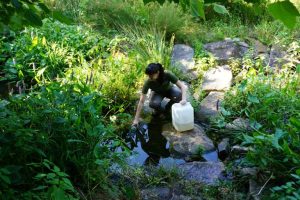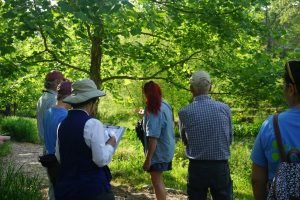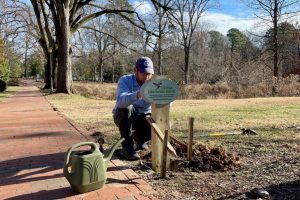On a spring morning in 2022, members of UNC Grounds and Landscaping and Sustainable Carolina met up with a New Hope Audubon Society team in the lush green space sandwiched between Coker Arboretum and Forest Theatre. Though the meeting felt relaxed, UNC Grounds team member Geneva Green felt some pressure. She dedicated many hours to the space, and always described it as her favorite place on campus.
“I truly believe that landscapes are the first connection many people feel to the Earth,” said Green. “For our students, it may be a secluded bench under a fringe tree or a favorite oak in a forgotten courtyard.”
 A regenerative renaissance
A regenerative renaissance
Unassuming from the roads that surround it, Battle Grove went through its own little renaissance back in 2008. That year, work began to uproot the pipes trapping part of Battle Branch stream beneath the ground. By 2016, a regenerative stormwater conveyance area took shape.
Today, Battle Grove functions as a living laboratory for Carolina students. Chief Sustainability Officer Mike Piehler has taken his past Sustainable Triangle Field Site classes out to the area to teach about water quality and stream health.
“With my background in water quality, I’m quick to think about the wonderful benefits this kind of project has like decreasing stormwater runoff and removing pollutants” said Piehler. “But as the amazing native plants have thrived, I’m really excited about the tremendous habitat value.”
 Battle Grove habitat assessment day
Battle Grove habitat assessment day
New Hope Audubon’s Bird Friendly Habitat Certification focuses on native wildlife. The independent chapter of the National Audubon Society explains that birds and other wildlife prefer areas rich in native plants. Although birds can consume fruits, nuts and seeds from non-native plants, to truly thrive, they need to eat insects. Insects much prefer to take up residence in native, as opposed to non-native, plants.
After years of planning, planting and preparation, Geneva Green felt confident that Battle Grove would be certified. At that point, an estimated 90% of the area was filled with native plants. Birds flocked to the area, there was a resident turtle and occasionally, a river otter made an appearance.
On the morning of the assessment, two plant experts, Alan Johnson and Don Pelly, and two recorders, Carol Hamilton and Joanne Abel, greeted the Carolina team. The visit consisted of a walkthrough, which meandered through Battle Grove’s intersecting paths. The team stopped at trees, shrubs and grasses to verify the plant list Green sent to the team prior to the visit.
But New Hope Audubon doesn’t just care about the number of native plants; they also look at the layers of native plants.
In its report on Battle Grove, New Hope Audubon wrote, “Battle Grove has a good number of canopy trees on its borders and a good number of trees within its boundaries. The shrub layer is well developed and there are many native perennial flowers, grasses and sedges.”
Red maples, catalpa and ash trees make up some of the canopy. The New Hope team also noted two hop hornbeam trees, while usually considered the understory, were “quite large” and provided some canopy in Battle Grove. The team specifically noted the black locust and slippery elm saplings within the understory.
The understory is also home to the storied pawpaw tree, a tree native to Canada and the eastern United States. In the 1990s the tree almost entirely disappeared from the landscape. During that time, people were clearing large canopy trees on the banks of streams and rivers. Pawpaws craved the shade they received from the canopy. When the canopy was uprooted, many pawpaws didn’t survive.
Today, the trees have their own fandom – both for their history and their fruit, which tastes like a banana, mango or pineapple, depending on who you ask.
Habitat improvements
In addition to assessing native plants, New Hope Audubon also assessed the number of additional wildlife improvements made in Battle Grove. UNC Grounds successfully implemented 6 out of the 11 improvements:
- Minimum amount of non-native turf grasses in the area.
- Nesting habitats are available for pollinators and other beneficial insects.
- Wildlife water feature present in area.
- Nest boxes for brown headed nuthatches and/or bluebirds.
- Variety of nectar and host plants blooming throughout the season to support pollinators.
- Minimal use of organic fertilizers.
The work is never done
The UNC-Chapel Hill team received praise for the work done at Battle Grove. One section of our report read:
This is a lovely display of how stormwater management sites can be turned into an asset to the community. The Audubon team feels like it will be a good place to send homeowners who have wet areas in their yard to show them how to transform them into a vibrant garden!
The thing about having a “wild” space like Battle Grove is that the work is never really done. Trees age, invasive plants may infiltrate areas and litter gets into waterways. New Hope warned us about a particular weed present in the area called oriental false hawksbeard. Though it looks like a dandelion, it can spread quick. So in February and March, Sustainable Carolina will likely gather a team to help curb its growth. Other problem plants include pale yellow iris, hellebores and European buckthorn.
And remember the ash trees? Unfortunately, those trees need to be treated for a pest called the emerald ash borer. While it would cost about $800 to treat each tree, New Hope believes it would be worth it for perseveration of the canopy and Battle Grove.
As future generations of Tar Heels move through campus, we hope Battle Grove continues to flourish. The area provides a place for students to study, enjoy nature and take a break from the stresses of higher education. It represents what’s possible when we work with nature and coexist with it.
“I can imagine a campus that has water moving from one end to the other,” said Green. “Natural springs and streams popping up, creating pockets of wildness surrounded by our majestic trees and our traditional plantings. There is room for everything – water, plants, pollinators and people.”
Sustainable Carolina hosts events at Battle Grove during the year. These include BioBlitz events, where students use the iNaturalist citizen science app to observe and track wildlife in the area. We also host trash cleanups when needed. We invite all students, staff and faculty to explore this area. It’s a great place to take a break or get some work done.
